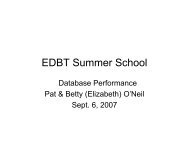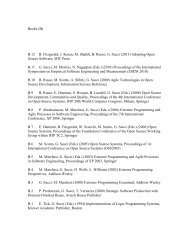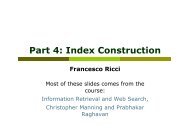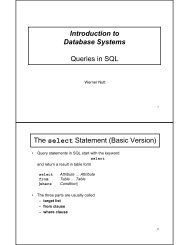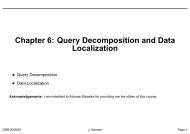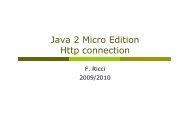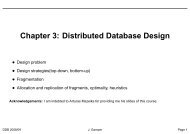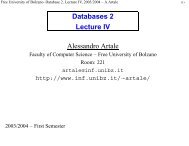The Application of JavaCC to Develop a C/C++ Preprocessor
The Application of JavaCC to Develop a C/C++ Preprocessor
The Application of JavaCC to Develop a C/C++ Preprocessor
Create successful ePaper yourself
Turn your PDF publications into a flip-book with our unique Google optimized e-Paper software.
eplacement, the syntax analyzer reads in each non-numeric <strong>to</strong>ken and checks against the lookup<br />
table that s<strong>to</strong>res the predefined macros. <strong>The</strong> searching in the lookup table is time consuming and<br />
the large lookup table occupies a significant amount <strong>of</strong> resources in the Java Virtual Machine.<br />
<strong>The</strong> direct replacement <strong>of</strong> macro is handled in the main preprocessor. <strong>The</strong> code for such operation<br />
follows:<br />
t= // Read in a non-numerical <strong>to</strong>ken<br />
{<br />
//Check if the <strong>to</strong>ken is a predefined macro<br />
if (DefineSet.isDefined(t.image)) {<br />
DefineHandler dh = DefineSet.getDefinition(t.image);<br />
}<br />
//Check <strong>to</strong> see if the <strong>to</strong>ken is a Simple Macro<br />
if (dh.isSimpleMacro()) {<br />
//Replace the <strong>to</strong>ken with the predefined macro<br />
resultingFile.print(" "+dh.replace());<br />
}<br />
} else { //it is not a definition nor a macro<br />
resultingFile.print(" "+t.image);<br />
}<br />
<strong>The</strong> replacement algorithm checks each identifier against the lookup table. If the matched<br />
identifier requires direct replacement the macro will be replaced with the suggestion.<br />
However, the macro definition with parameters, or function-like macro definition requires a more<br />
complex algorithm for expansion. For example, given the macro definitions:<br />
#define addition(A,B)<br />
A + B<br />
<strong>The</strong> call addition(Parameter1, Parameter2) yields Parameter1 + Parameter2. <strong>The</strong><br />
problem <strong>of</strong> macro definition is further complicated by the introduction <strong>of</strong> # and ## opera<strong>to</strong>rs. <strong>The</strong><br />
# opera<strong>to</strong>r will be replaced in the expansion by a string literal corresponding <strong>to</strong> the argument,<br />
while the ## opera<strong>to</strong>r concatenates the argument and the adjacent <strong>to</strong>ken <strong>to</strong>gether. Consider the<br />
following example (for more complex cases, see [6]):<br />
#define message(m) Print(m #)<br />
#define hello(a) Hello ## a<br />
<strong>The</strong> call <strong>to</strong> message(test) and hello(World) gives the following results respectively:<br />
Print("test") and HelloWorld.<br />
Generally, the body <strong>of</strong> the complex macro consists two types <strong>of</strong> elements:<br />
1. Bound Element – <strong>The</strong> constant part <strong>of</strong> the macro that does not need <strong>to</strong> be processed<br />
2. UnBound Element – <strong>The</strong> argument part <strong>of</strong> the macro that needs <strong>to</strong> be replaced by the passedin<br />
argument when called<br />
<strong>The</strong> introduction <strong>of</strong> these two elements <strong>to</strong> describe the macro body breaks down the body <strong>of</strong> the<br />
directive #define addition(A,B) in<strong>to</strong> three components as follows:<br />
1. UnBound Element – A<br />
2. Bound Element – +<br />
3. UnBound Element – B<br />
16



